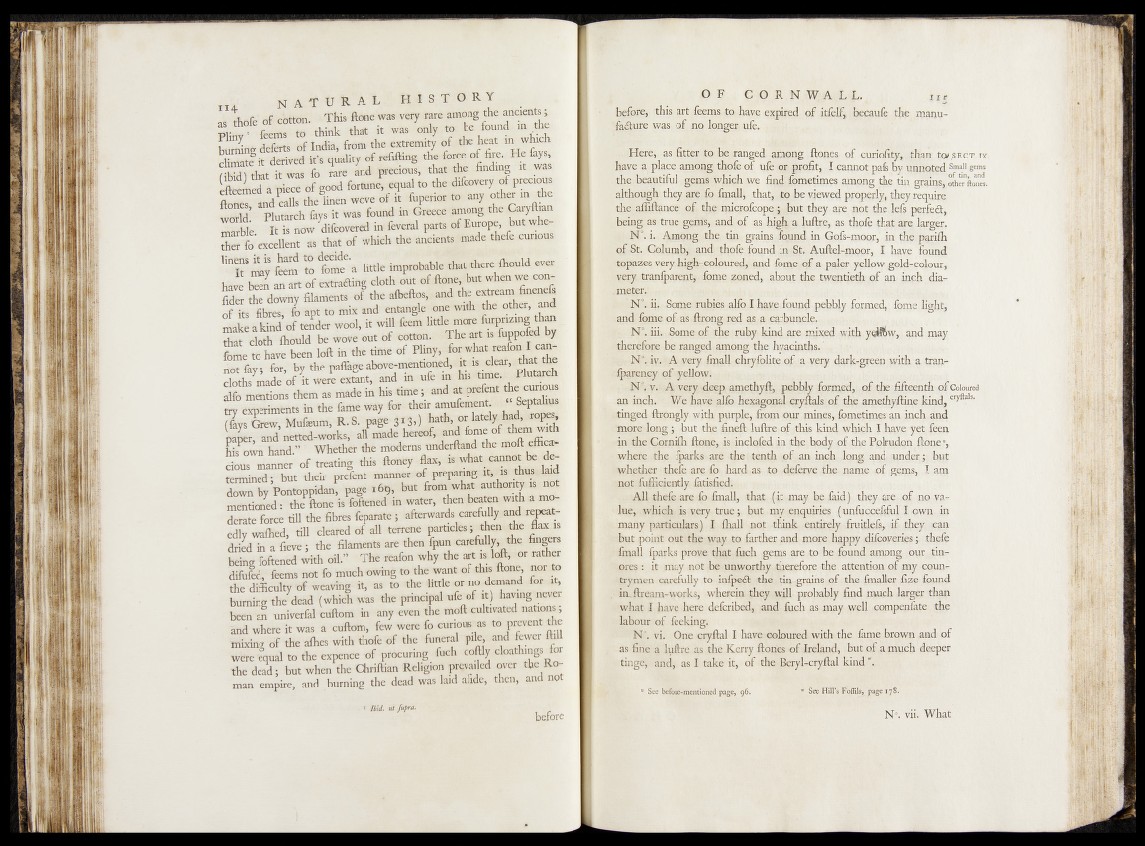
j g l n a t u r a l h i s t o r y
i brac; ofI cöttön. This done was very rare among the ancients^,
2 S3 S5 m^ I® «* f w M w
(J £ L d i piece o f good ^ fiottts, and calls the linen wove of it fuperror to any other m the
world' Plutarch fays it was found in Greece among the Caryftian
S ia fa e ra l part* ofEurope hutwhe-
J t e f e j d t a * « . that of »hid. the andenfctode « * • > •
'“ 5“ « ' roan to fotne a little improbable that there Ihould t w
have been an artof extracting cloth out of ftone^ but when we con-
f i £ P J S filaments of the albedos, and
of its fibres, fo apt to mix and entangle one with the other, and
make a kind of tend«* wool, it will feem by
that doth Ihcmld be wove out of cotton. The .art is iuppoted ny
feme to hare beet, loft in the time of
ri-of f a v for by the paffage above-mentioned, it is clear, .that the
S b m a T o f h w ^ e x S i t , and in ufe in his
S m S t i o m d r e m a t n ^ i n lm thne;
mr experiments in the Curie way f a then amnifement. _ Septahns
(feysGrew. Mufenm, U » » )
oaoer and netted-works, all made hereof, and fom I „
his^own hand.” Whether the moderns underhand the mod effica»
g g S g Of treating this dcmeyffiax, - Q g M É M § £
termined; but their prefent m a n n e r of p repa ra a t,vis
downby Pontoppidan, page x6t>, but
mentioned: die done W fodened in water, then beaten with a mo-
£ £ force till the fibres feparate; afterwards carefiilly- and rqieat-
edlv walhed, till denied of all terrene particles; then the flax is
Ótkd in a fieve; the filaments are then foum carefially the fingers
tó n g foftened with oil " The reafon why die art is lofb, or rather
difuld, feems not fo much owing to the want of this done, no
the difficulty of weaving it, as to the little or no demand for it,
burning the dead (which was the principal ufe of it) ^ m g never
been an univerfal cudom in any even the mod cultivated nations,
and where it was a cudom, few were fo curious as to pavent the
mixing Of the affies with thofe of the ftmeral pile and fewer did
were equal to the expence o f procuring fuch coftly cloathings fm
the dead; but when the Chridian Religion prevailed over the Roman
empire, and burning the dead was laid afide, then, and not
‘ Ib id , lit fu p ra .
before
O F C O R N W ;A L U l i t
before, Shfi-art feems to have expired of ifièlf, becauiè the manu-
'failure was, of jiQ longenufe.
.. Here, as fitter to be-ranged among dopes, of curiofity,foun to/SECT.ix.
have a,place among: thofe of ufe qr profit, I eapnot/pafs by unnoted Sm^u gems
the, beautiful gem» which we find fomçtimes among tfitj tin grains,^b^fto^ei.
although they are fo fmall, that, >to be viewed propefly, they require,
the affidance o f th| iuicrofcope ^fiut they are pot foe (eff pqfie£t,
being as true ggiris, and, of as high* a (uffie, as thofe that are larger.
N°. i. Among the tin grains fqund in Gofs-niopr, in the parifh
of St. Columb,. and thofe found ip St. Audel-rnoor, I have found
topazes very high-coloured, and feme o f a pgfer yçllow gold-colour,
very, tranlparefit, feme zoned, about the twentietli o f an inch dia-
, meter.. ~
ii. Some rubies alfo I haveToupd pefebl^ foon?4* fome;hghf>
and feme of as drong red as a carbuncle. .
fe N°. in.. Someofthe ruby kind are nfixed with yeèîbw, and may
therefore jbp ranged among the hyacinths. .
iv- jA,yery final} chryfolite of a very dark-green with a trap-
fo§rency ofyellow,
N°, v. A very, deep, amcfhyfi, pebbly formed, of the fifteenth o f Coloured
an inch. We have alfo hexagonal crydals of the amethydine kind,cryltals’
tinged drongly with pprple, from our mines, fcmetimes an inch and
i|nqre|oi^ the fined luffreicf^this kfo4 whfoh I hayp; yetjgpii
in the Gornifh donp, is dnclt^cl in the body pfsfhe Ppfrufion done”,
where the Iparks arc the tenth of an inch loug and: funder. but
whether thefe are fo hard as to defcrve the name o f gems, I am
■ nottfu^ciently làtisfied.
All thefe are fo fmall, that (it-may be laid) they ar;e of no ya*
lue, .which is very true; but my enquiries {unfocqefojul I own in
many particulars) I ffiall not think aUvely-fru^e^
but point out the way to farther and more happy diicoverigs ; thefe
frnall fparks prove that findi gems are to be found amongf o ^ t in -
ores : it may not be unworthy therefore the attention of my countrymen
carefully to infoeét ffie .r tin-grains p f fthe finaller fixe foun^
in_dream-works, wherein they will probahly find much larger than
what -I have here defcribed, and, fiiph as may well vçompeufote the
labour of feeking.
N p. vi. One crydal I have‘.coloured with'the fame, brown .and of
as fine a ludre as the Kerry dopes of Ireland, but of a much deeper
^ tinge, and, as I take it, of the Beryl-crydal kind”. ,
u See before-mentioned page, 96. ;|USeeNteirè Foffijs, page 178.
N°. vii. What